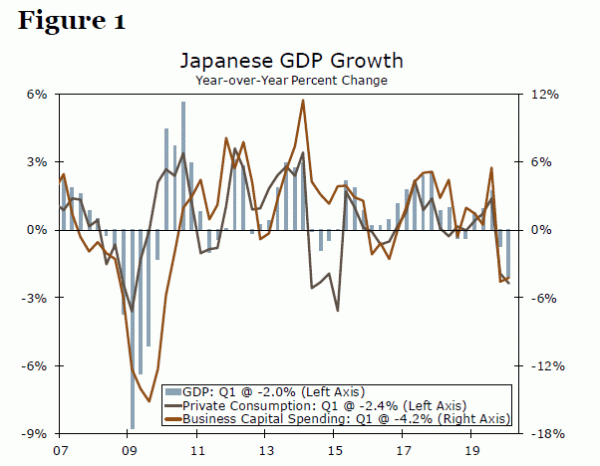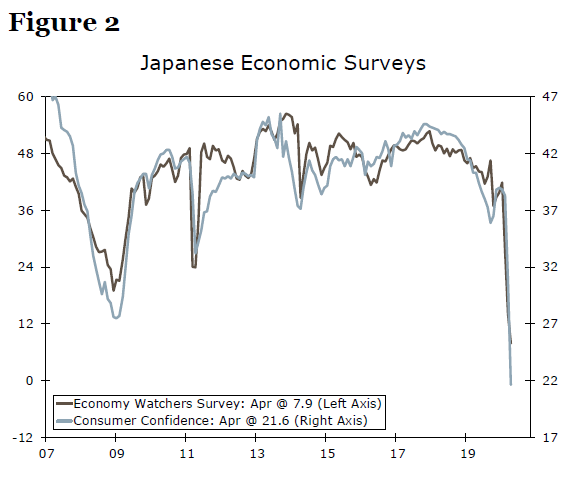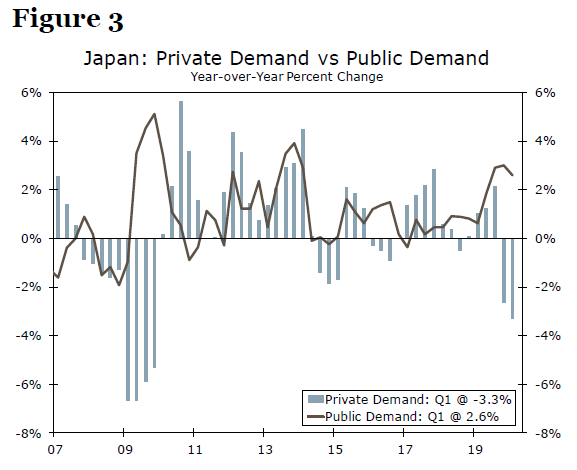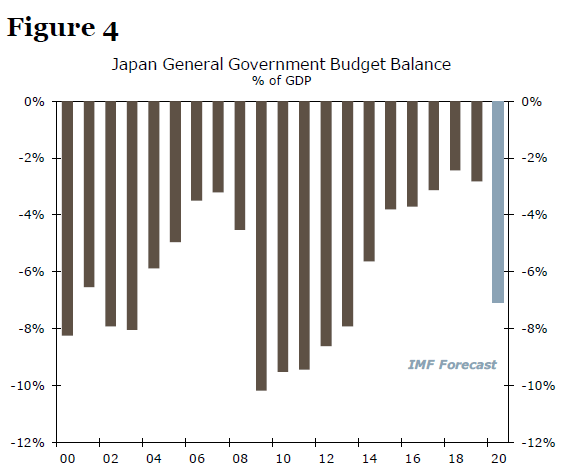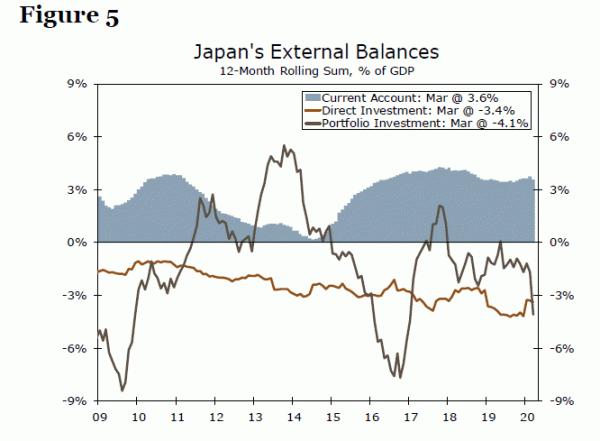Executive Summary
- Japan’s first quarter GDP fell less than expected, although there were some concerning elements in the details of the report. Private sector activity was particularly weak, while we note that leading indicators are consistent with a much sharper decline in GDP in the second quarter.
- So far, the Bank of Japan has made only modest policy adjustments, while the government has made more substantial fiscal policy adjustments. Neither of those policy responses, however, are in our view likely to be sufficient enough to prevent a further downturn, or prompt a significant bounce back in activity.
- Considering the underlying currency and capital flow picture, we have become less positive on the Japanese currency and see only a modest gain in the yen over time.
Japan Back in Recession
Japan’s Q1 GDP figures released earlier this week indicate the economy has returned to a technical recession. Overall GDP fell 3.4% quarter-over-quarter annualized in Q1, which was less than the consensus forecast, and by 2% year-over-year (Figure 1). Meanwhile, headline GDP was not as bad as expected, but the details of the report were less encouraging. Specifically, private consumption shrank 2.8% quarter-over-quarter annualized and business capital spending shrank 2.1% quarter-over-quarter annualized, both registering their second straight quarterly declines.
While the first quarter outcome was to some extent affected by COVID-19-related restrictions, it is important to note that Prime Minister Abe’s declaration of a state of emergency and tougher restrictions did not come into effect until early April. Accordingly, even if Q1 GDP was betterthan- expected—although by no means good—the likelihood is for a much larger contraction in economic activity in Q2, with the risks tilted toward a worse-than-expected outcome. While there are little hard activity data for Q2 at this point, survey data clearly point to a challenging environment ahead. The current conditions component of Japan’s economy watchers survey fell to a record low 7.9 in April, while consumer confidence fell to 21.6, also a record low (Figure 2). The consensus forecast is currently for Q2 GDP to decline 22% quarter-over-quarter annualized. Given the possibility of a worse-than-expected Q2 GDP, we are not (yet) inclined to adjust our full-year 2020 GDP forecast for a fall of 5.6%. That said, we anticipate any near-term revisions to that 2020 forecasts would likely be in the direction of a larger decline.
Policymakers Plans Proceed, but No Panacea
Another interesting theme from the Q1 GDP report, and one that is clearly related and relevant for monetary and fiscal policy, is the contrast between the weakness of private demand and somewhat stronger public demand. Reflective of the declines in consumer and investment spending referred to earlier in this report, real private demand fell 3.3% year-over-year in Q1, while public demand was somewhat firmer, rising 2.6% year-over-year (Figure 3). The contrast with the weakness of the private sector clearly illustrates the need for policymakers to support the economy, while the somewhat more solid public sector spending reflects the efforts of policymakers to provide that support.
Turning first to monetary policy, in our view, there are limits to the willingness or ability of the Bank of Japan to provide significant support at the current juncture. The central bank has outlined a range of measures since the start of this year, including
- Doubling its ETF purchase target to ¥12T from ¥6T.
- Increasing the use of its U.S. dollar swap facility with the Federal Reserve and making those funds available to Japanese financial institutions.
- Introducing special funds-supplying operations to facilitate corporate financing, due to COVID-19.
- Increasing the purchase target for commercial paper and corporate bonds to ¥20T.
- Indicating that it is willing to purchase Japanese government bonds (JGBs) in unlimited amounts. However, given that the current pace of net JGB purchases (¥14T over the past 12-months) is running well below the previous target of ¥80T per year, it is arguable that this adjustment is more symbolic than substantial.
Overall, we do not view the Bank of Japan’s policy actions so far this year as being as forceful as that of other major central banks, which have included policy rate changes as well as very largescale asset purchase programs. Accordingly, we doubt the central bank’s actions will be sufficient to revive, or even stabilize, private sector activity. Moreover, we do not expect any further decisive policy moves from the Bank of Japan in the near term.
Instead, we think it will likely fall on fiscal policymakers to bear the brunt of policy efforts to stabilize the economy. After raising the consumption tax in October 2019, the government has since introduced several rounds of fiscal stimulus. Typically, the headline figures for the fiscal packages are particularly impressive, in that they include previously announced measures and, in addition to actual fiscal spending, include loans, guarantees and sometimes private sector involvement. The fiscal package announced by the Japanese government in early April was no different, with a headline figures of ¥108T (around 20% of GDP) and actual spending of ¥39.5T (around 7% of GDP—still an impressive amount). In addition, recent reports indicate that the government is now considering a second extra budget, although the size and scope of the budget is not fully clear at this point.
Another perspective to gauge the extent of fiscal stimulus is to examine the change in the budget balance, which reflects changes in both tax and spending policies, as well as swings in the economic cycle. In its latest update, the International Monetary Fund projected a widening in the general government budget deficit to 7.1% of GDP in 2020 from 2.8% of GDP in 2019, suggesting substantial fiscal expansion (Figure 4). In our view, Japanese fiscal policy, rather than monetary policy, will play the largest part in offering some stability to the economy and preventing an even larger economic decline this year.
Currencies and Capital Flows
With growth fundamentals, along with monetary and fiscal policy, not pointing to a near-term bounce in the Japanese economy, we also briefly examine recent trends in Japanese external balances to see if those external currency and capital flows might offer reasons for a positive yen outlook. While the figures cannot offer a definitive conclusion, recent balance-of-payments data suggest currency and capital flows have become less supportive of the yen rather than more supportive of the yen.
Japan’s current account surplus has remained sizable, at 3.6% of GDP in the 12 months-to- March-2020. Net foreign direct investment, which has also been relatively stable over many years, showed a net outflow of 3.4% of GDP over the same period. The swing factor, however, has been net portfolio flows, where outflows accelerated to 4.1% of GDP over the past 12 months (see chart below). Looking in a bit more detail, the change in portfolio flows stems mainly from net debt flows. While Japanese purchases of foreign debt securities have been relatively steady over the past 12-months, foreign purchases of Japanese debt securities have slowed markedly, contributing to the worsening overall net balance. In our view, the currency and capital flow picture is more consistent with only gradual yen gains (or even yen losses), rather than rapid yen appreciation. Overall, given the economic and currency fundamentals we highlighted earlier in this report, we have become less positive on the Japanese currency, and expect only a modest appreciation of the yen over time.




